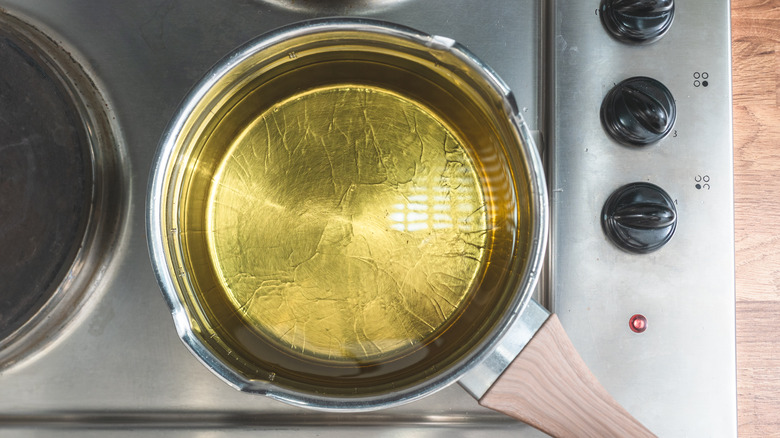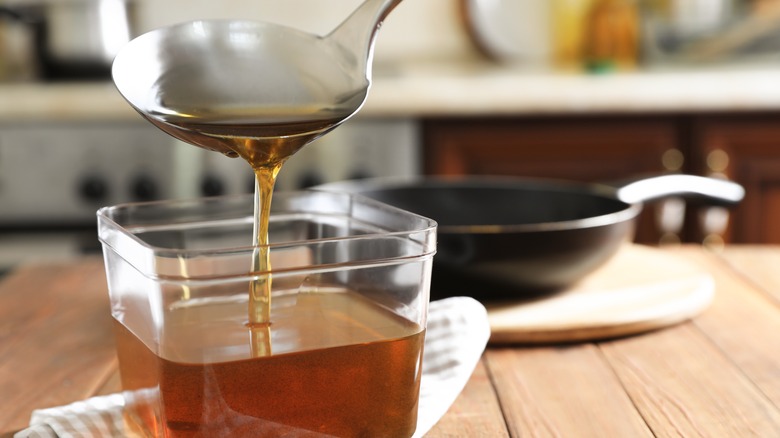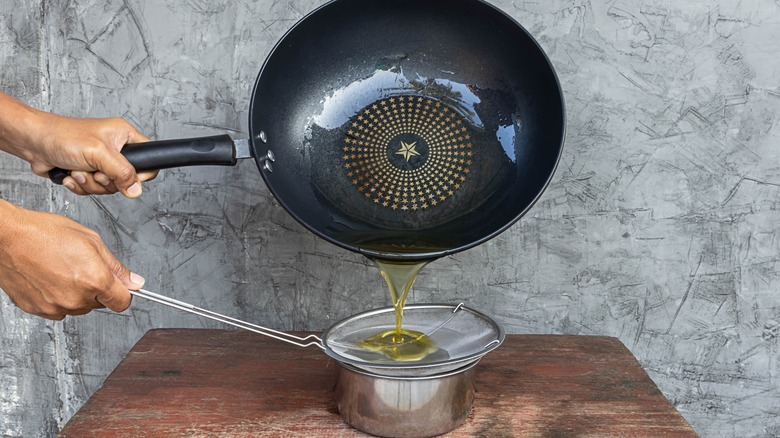Should You Be Reusing Your Cooking Oil?
It seems an awful shame to toss a big pot of oil that was only used to fry homemade tortilla chips or a single batch of a simple fried chicken recipe. The good news is that you can definitely reuse cooking oil, as long as you do so properly. In fact, restaurants typically don't throw out their oil after a single use, and you absolutely can do so in your home kitchen, for the same money- and resource-saving reasons.
After you're done frying your food, let the oil cool completely. Then, pass it through a fine mesh sieve, cheesecloth, or coffee filter into a resealable container, such as a mason jar or the original plastic bottle (so long as it's empty). You can also place a paper filter in a mesh strainer to catch as many food particles as possible. Label the container of oil with the date it was first used and what was fried in it, and every time you cook with it, write down how many times it has been re-used.
Unrefrigerated oil — especially with stray food particles — does have an increased likelihood of growing harmful bacteria. However, if you filter oil well and keep it in the refrigerator, the USDA notes that it will keep for up to three months. You can use the oil two to eight times, though finishing it within two months, or about three uses, is probably best for peak freshness.
What to consider when reusing cooking oil
When frying food — especially if you plan to save the oil — pick a refined oil that has a high smoke point, such as grapeseed, canola, peanut, safflower, or soybean. The refining process removes solid particles in the oil, making it more stable. Each time you reuse it, the oil will deteriorate it and the smoke point will decrease, making it more likely to burn. This is why it's important to pick one with a tolerance for high heat from the start.
If you accidentally burn your food, it's best to toss the oil, as it will have already degraded significantly from being heated until smoking. A deep-frying thermometer or candy thermometer can help you regulate the temperature during frying, to make sure the oil doesn't get too hot. It's also important to closely inspect any leftover oil before using it again.
Start off by smelling the oil. It will smell faintly of whatever you fried in it, but it should not smell sour, rancid, off-putting, or otherwise foul. If it smells bad or starts to foam when you heat it up, get rid of it. Because oil absorbs flavors, be mindful of what you cook when you reuse it. If you make sweet potato dessert empanadas first, you could make this fritto misto afterwards, because the fried dough is mild in flavor. However, if you attempted the reverse, you would end up with a shrimp-infused dessert.
How to clarify used oil
If you want to get your used oil as clean as possible, you can clarify it in addition to filtering. This technique is especially useful if you fried something that left behind a lot of fine debris, like bits of flour, cornmeal coatings, or thin batters. You can actually clean your dirty cooking oil with one convenient pantry staple: cornstarch. The process involves making a slurry and using it to capture food particles in the oil.
You can also use plain gelatin to achieve a similar result, though it does take longer. Let the oil cool to room temperature, and meanwhile, get your gelatin ready. Use 1 cup of water and 1 teaspoon of unflavored, powdered gelatin for every quart of oil. Heat the gelatin and water together and whisk until the gelatin fully dissolves. Then, add the gelatin mixture to the oil, whisking constantly. Allow to rest, covered, in the refrigerator for at least eight hours. The gelatin will create a "disk" in the middle of the oil that has trapped all the food debris. Discard the solidified gelatin and enjoy your reusable oil.



